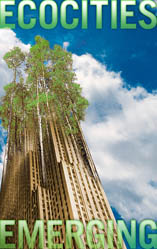Building on water eliminates flood risk and enables expansion
For thousands of years, human settlements have clustered around flood planes, from the banks of the Amazon River to lake Tonle Sap in Cambodia, to the marshes of the Netherlands. These settlements are designed to account for the seasonal ebb and flow of sea and fresh water, often by constructing buildings on raised platforms and/or building dykes, dams and canals. Yet as global climate change leads to increasing sea levels, almost every coastal city will face the challenge of encroaching waters.
Presenters at the Global Town Hall for infrastructure solutions held last week in Germany introduced innovative solutions for cities on the brink. “13 out of the world’s 21 megacities are harbor cities, of which Shanghai is most vulnerable to flood and related hazards,” said Professor Markus Quante at the town hall.
Instead of holding back the flood, several presenters suggested ways to completely re-imagine a city on the water. Rutger de Graaf from DeltaSync, a design firm that specializes in sustainable flood-proof urban development in delta areas, says cities can float on water and yet stay dry and resilient. Floating structures on water eliminate the threat of flood damage and can be a viable option for city expansion. In addition, city waste such as carbon dioxide and biowaste can be used to farm algae and in turn raise fish in urban areas.
“Urbanization in delta areas has caused increasingly severe flood. It has also added pressure on space, food, energy and other resources,” said de Graaf, adding that by 2025 the world will run short of at least 22 million km2 of land – an area equivalent to the North American continent.

Rijnhaven Pavijlioner. Images from DeltaSync
The city of Rotterdam is already experimenting with floating urbanization, building its first floating pavilion at the Rijnhaven harbor. Designed by DeltaSync, the three domed structures cover the area of four tennis courts and are not only self-sufficient, relocatable structures that purify their own waste water, but also rise automatically according to rising water levels. The city plans to add many more floating buildings, including a park, as part of the Rijnhaven harbor redevelopment master plan.
Another 1,200 floating structures are planned to open in 2040 in Stadhavens – an area designated for sustainable housing development, floating communities, recreation, and research on energy generation such as tidal energy and cooling and heating from river water.
The city of Semarang, the capital of Central Java, and other coastal cities are working with the Dutch to implement their water management expertise in their own districts. Semarang has already lost 98.2 hectares of land between 1991 and 2009 due to land erosion accelerated by climate change.
Find out more about DeltaSync’s project at their website.



 Posted by ngrunditz
Posted by ngrunditz 

